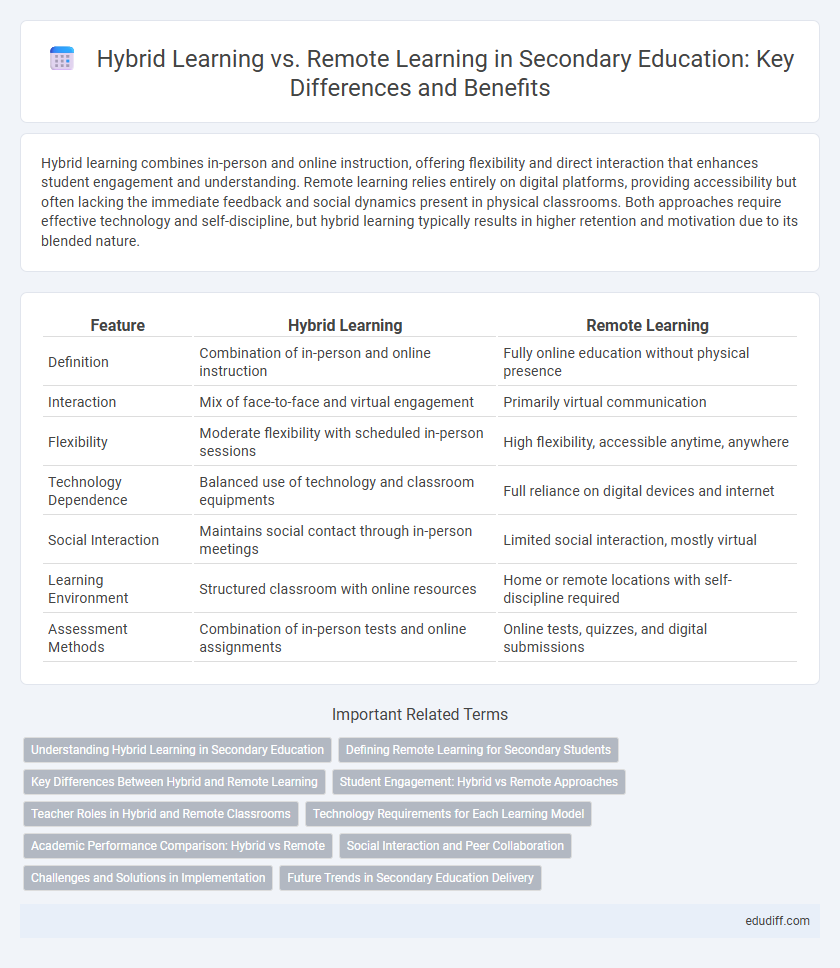Hybrid learning combines in-person and online instruction, offering flexibility and direct interaction that enhances student engagement and understanding. Remote learning relies entirely on digital platforms, providing accessibility but often lacking the immediate feedback and social dynamics present in physical classrooms. Both approaches require effective technology and self-discipline, but hybrid learning typically results in higher retention and motivation due to its blended nature.
Table of Comparison
| Feature | Hybrid Learning | Remote Learning |
|---|---|---|
| Definition | Combination of in-person and online instruction | Fully online education without physical presence |
| Interaction | Mix of face-to-face and virtual engagement | Primarily virtual communication |
| Flexibility | Moderate flexibility with scheduled in-person sessions | High flexibility, accessible anytime, anywhere |
| Technology Dependence | Balanced use of technology and classroom equipments | Full reliance on digital devices and internet |
| Social Interaction | Maintains social contact through in-person meetings | Limited social interaction, mostly virtual |
| Learning Environment | Structured classroom with online resources | Home or remote locations with self-discipline required |
| Assessment Methods | Combination of in-person tests and online assignments | Online tests, quizzes, and digital submissions |
Understanding Hybrid Learning in Secondary Education
Hybrid learning in secondary education combines in-person and online instruction to create a flexible and engaging learning environment. This approach allows students to benefit from face-to-face interactions while accessing digital resources and personalized learning tools remotely. Research shows hybrid models improve student motivation, attendance, and academic performance by blending traditional and technology-enhanced methods.
Defining Remote Learning for Secondary Students
Remote learning for secondary students involves instruction delivered entirely through digital platforms, enabling education beyond traditional classrooms. It utilizes video conferencing, online assignments, and digital collaboration tools to facilitate real-time interaction and asynchronous learning. This approach supports flexible scheduling and access to diverse resources, catering to varied learning styles and ensuring educational continuity outside school premises.
Key Differences Between Hybrid and Remote Learning
Hybrid learning combines in-person and online education, offering flexibility and direct student-teacher interaction, whereas remote learning occurs entirely online without physical classroom attendance. Hybrid models facilitate real-time collaboration and hands-on activities, enhancing engagement, while remote learning relies solely on digital tools and self-discipline. Key differences include the degree of social interaction, technology dependence, and the learning environment dynamics.
Student Engagement: Hybrid vs Remote Approaches
Hybrid learning models enhance student engagement by combining in-person interaction with digital flexibility, fostering collaboration and immediate feedback. Remote learning often faces challenges in maintaining consistent engagement due to limited physical presence and increased distractions. Data shows hybrid classrooms report higher participation rates and improved learning outcomes compared to fully remote settings.
Teacher Roles in Hybrid and Remote Classrooms
In hybrid classrooms, teachers balance in-person and virtual instruction, adapting lesson plans to engage both online and physically present students simultaneously. Remote learning requires educators to utilize digital tools extensively, fostering student interaction through virtual platforms while monitoring participation remotely. Effective hybrid and remote teaching necessitates strong technological proficiency and flexible communication strategies to support diverse learning environments.
Technology Requirements for Each Learning Model
Hybrid learning requires a reliable combination of in-person and virtual technology, including high-speed internet, interactive whiteboards, and video conferencing tools to facilitate seamless transitions between classroom and online sessions. Remote learning depends heavily on robust digital platforms, such as learning management systems (LMS), stable internet connections, and compatible devices like laptops or tablets to ensure effective participation from home. Both models demand adequate cybersecurity measures and technical support to maintain smooth operation and protect student data.
Academic Performance Comparison: Hybrid vs Remote
Hybrid learning fosters improved academic performance by combining in-person engagement with digital flexibility, allowing students to benefit from direct interaction and personalized support. Remote learning often faces challenges such as reduced student motivation and limited real-time feedback, which can hinder comprehension and retention. Studies indicate that hybrid models typically yield higher test scores and better overall achievement compared to fully remote setups in secondary education.
Social Interaction and Peer Collaboration
Hybrid learning enhances social interaction and peer collaboration by blending in-person engagement with online flexibility, allowing students to participate in group discussions, collaborative projects, and real-time feedback both inside and outside the classroom. Remote learning often limits spontaneous social interactions and peer engagement, relying heavily on scheduled virtual meetings and digital communication tools which can hinder the development of interpersonal skills. Studies show hybrid models improve student motivation and teamwork by offering diverse interaction opportunities compared to fully remote setups.
Challenges and Solutions in Implementation
Hybrid learning faces challenges such as ensuring equitable access to technology and maintaining student engagement both in-person and online, with solutions including deploying adaptive learning platforms and providing comprehensive teacher training on digital tools. Remote learning struggles with limited social interaction and inconsistent internet connectivity, which can be addressed through synchronous virtual collaboration sessions and investing in community Wi-Fi hotspots. Effective implementation hinges on continuous stakeholder feedback and the integration of data analytics to tailor instructional strategies and support student progress.
Future Trends in Secondary Education Delivery
Hybrid learning in secondary education combines in-person and online instruction, enhancing flexibility and personalized learning experiences. Future trends emphasize adaptive technologies and AI-driven platforms to tailor content and assess student progress in real-time. Remote learning continues to evolve with improved virtual reality tools, enabling immersive and interactive environments that support diverse learning styles.
Hybrid Learning vs Remote Learning Infographic

 edudiff.com
edudiff.com